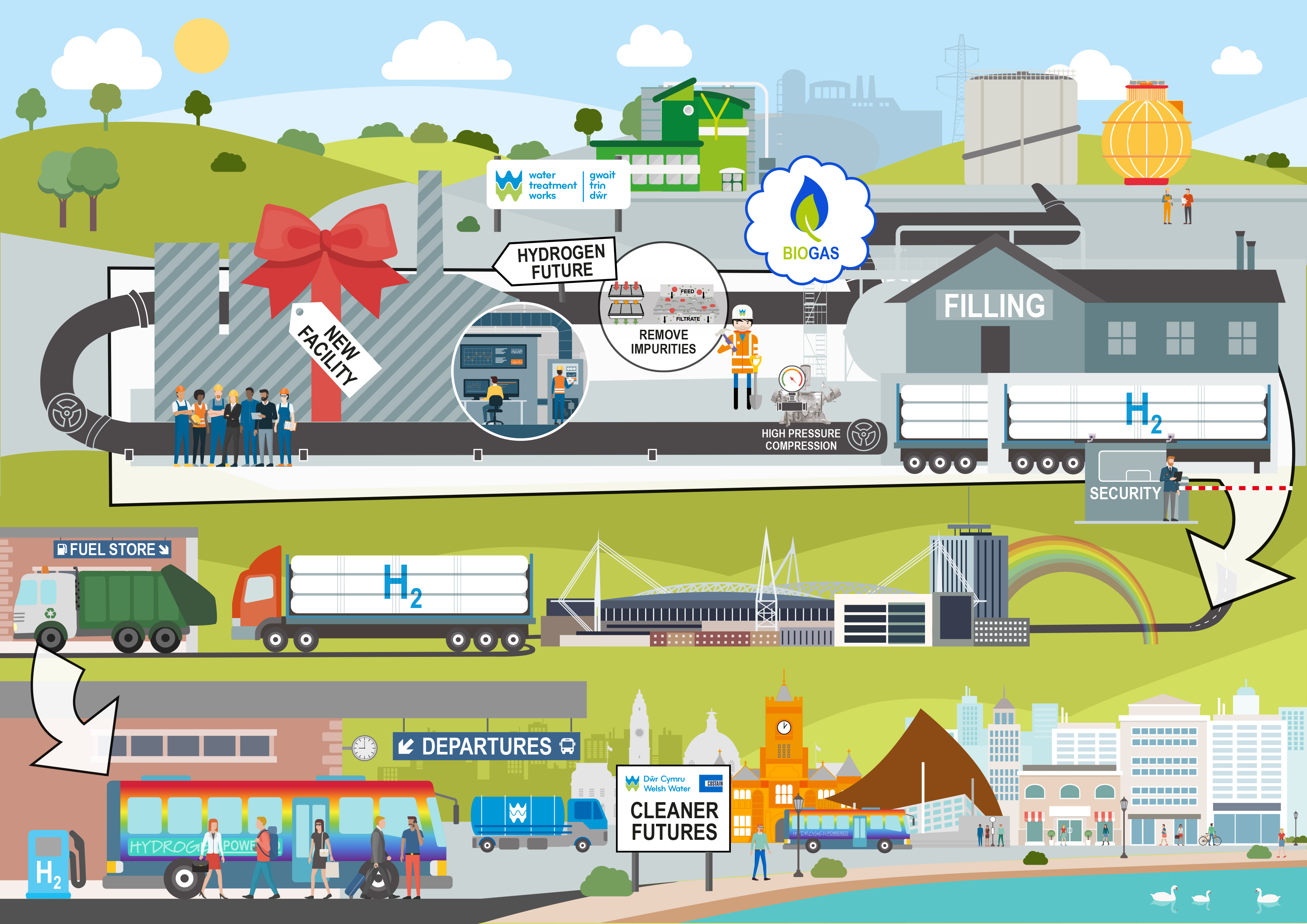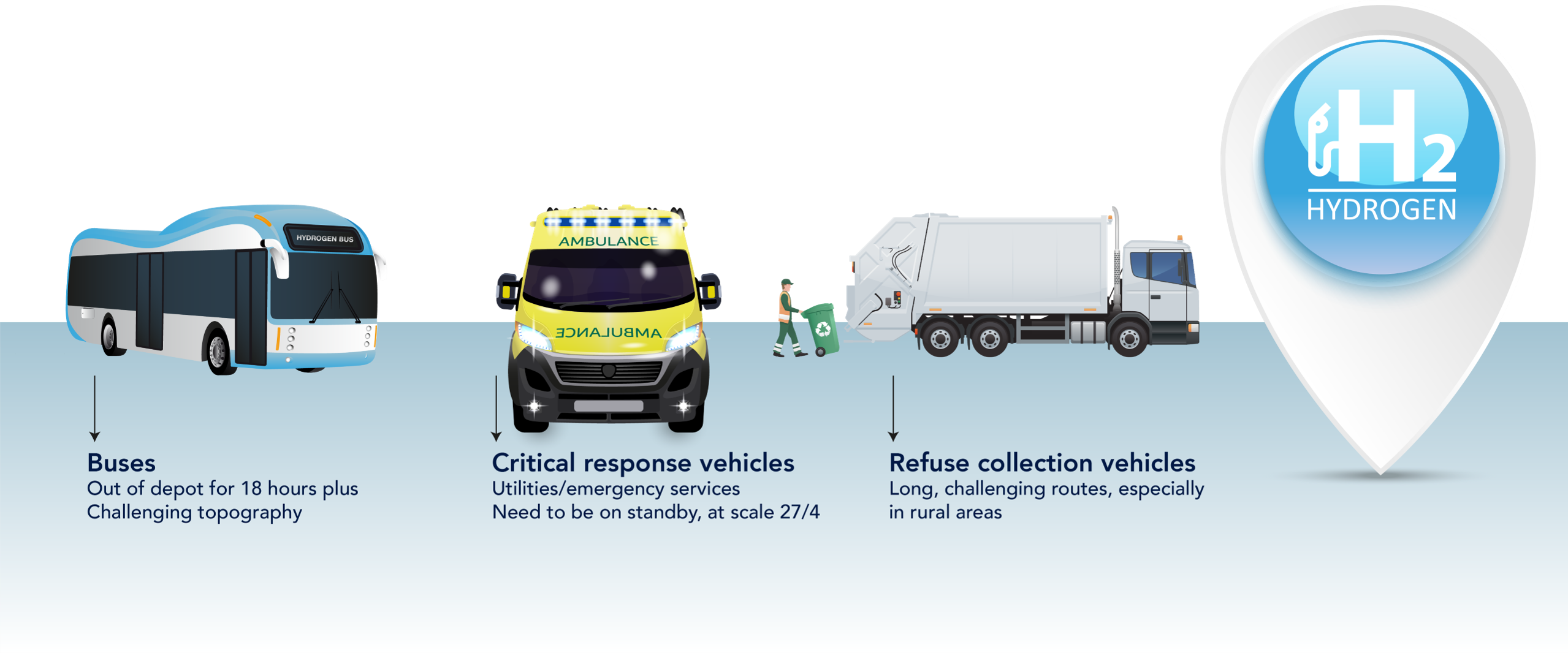
Developing a renewable hydrogen source for vehicle fleets
Investigating the possibility of generating hydrogen from sewage waste gases to power fleet vehicles, creating a localised hydrogen circular economy.
- Service 1
Consultancy and advisory
- Service 1
Cardiff Council on behalf of the Welsh Government
- Service 1
Innovate UK
Key benefits
Potential to produce enough fuel grade hydrogen
to power heavy duty fuel cell electric vehicles that would avoid 9000 tonnes of CO2 per year being emitted by diesel powered equivalents
Potential to reduce air pollution in the region, avoiding the release of 137kg of particulate matter (dust) per year currently emitted by equivalent volumes of diesel-powered vehicles
If trial is successful, a UK-wide roll out could produce* up to 20 million kg of hydrogen per year, enough to fuel 2,850 hydrogen buses
Having been awarded funding by Innovate UK, Costain and Welsh Water are working in close collaboration to develop a hydrogen production facility in South East Wales, using waste gases from the sewage treatment process as a source to produce fuel grade hydrogen. The renewable hydrogen could power local fleet vehicles (including Welsh Water’s fleet), saving significant amounts of carbon emissions and improving air quality.
The company has four large sludge treatment centres – with one being Wales’ only gas-to-grid system. In future, these plants could convert sewage derived biogas to renewable bio-hydrogen, helping decarbonise heat and transport.
A demonstrator project is planned, located in Cardiff. The plant would utilise 35GWh of biogas to help generate 2000 kg per day of hydrogen, enough to fill up the equivalent of 100 buses. If this amount of hydrogen was used in hydrogen powered fuel cell electric vehicles (FCEV), it would avoid over 9000 tonnes of CO2 being released into the atmosphere every year. It would also significantly reduce air pollution in the region, avoiding the release 137kg of particulate matter (dust) per year compared to diesel-powered vehicles (equivalent to 7 million km of clean bus journeys).
Producing bio-methane or even bio-hydrogen is an important step towards meeting Welsh Water’s ambition to reach net zero by 2040 and a achieve a 90% reduction in emissions by 2030. Using the biogas to produce renewable fuels could have up to 10 times larger decarbonisation impact than using it to produce renewable electricity.

As well as proving that the production process was feasible, it was important to ensure there was sufficient demand for the volumes of hydrogen the plant could produce. This was important in order to give Dŵr Cymru Welsh Water confidence in the economic viability of the scheme. Costain worked with Cardiff Council on behalf of the Welsh Government to study the potential demand for hydrogen in decarbonising road transport across the region, focusing on the following aspects:
- The total cost of ownership of FCEVs vs internal combustion engine and battery electric equivalents (focusing on buses and refuse collection vehicles)
- The appetite for FCEV uptake if the technology was available and economically viable
- The options for funding hydrogen distribution and storage infrastructure as well as procurement of hydrogen fuel cell vehicles
The study concluded that there was significant potential and appetite within the region for vehicles to be converted to hydrogen. This includes buses, refuse collection vehicles, and critical response vehicles, particularly blue light vehicles for the police service.

The results also suggested that the potential hydrogen fuel cell vehicle user demand in South East Wales could meet all daily production from the proposed facility within two years of operations, commencing in the mid-2020s.
By drawing on our energy, water and transportation infrastructure knowledge to study both the feasibility of the upstream hydrogen production and the downstream demand requirement for hydrogen-powered vehicles, we have demonstrated both the technical and economic viability of the project.
The success of the demonstrator project will enable wider investment in renewable hydrogen projects across Wales and the UK, meaning this project has the potential to significantly reduce carbon emissions and reduce air pollution.
* The UK water industry estimates that approximately 2 TWh of biogas can be diverted to produce biomethane. If half of the biogas (1 TWh) is used to produce low carbon hydrogen (20-30 facilities across the UK), the industry has the potential to produce 20 million kg of hydrogen, enough to fuel 2,850 hydrogen buses. The latter would reduce CO2 emissions associated with transport by over 250,000 tonnes per year.
Climate change demands that we make an impact now and we believe that this project could have a big impact within the South Wales region by 2025 rather than by 2030. It’s a great showcase of what is possible if we all put our heads together and all move in the same direction.
Contact and social
Water
